The new LEED-ND standards: what’s new, what’s good, and what’s not (part 3)

Posted May 9, 2009 at 1:57PM
This is the final installment of three parts that I have been writing on the new LEED for Neighborhood Development standards, which are open for public comment until June 14. Part 1 is here, and Part 2 is here. Today I am writing mostly about the third major section of LEED-ND, "green infrastructure and buildings." As before, the images are of projects that have been certified under LEED-ND's pilot program.
(I know this is a really hard-core series of posts. Bear with me, and I'll get back to my usual frivolity after today.)
As I noted before, I believe LEED-ND should comprise a set of standards that defines what is smart about smart growth, separates true environmentally superior land development from the pretenders, and rewards developers who are leading the way, in the right locations with the right design. And I believe that the program should not bestow its honors on development in the wrong places, no matter how good the internal design. If we want to provide counter-incentives to sprawl, we must not honor sprawl locations. (The other LEED programs do enough of that, in my opinion; this one is supposed to be different.)
That said, today's subject is design and operations.
The green infrastructure and buildings ("GIB") category
I have changed my views about the importance of green buildings and technology in LEED-ND over the years that I have been involved with the program. Originally, I wasn't sure that we should address green technology issues at all, since those were adequately covered in the other LEED programs. 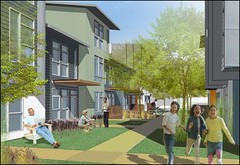 The deficit was in location and neighborhood pattern, which historically have been all but ignored in LEED. I thought both the traditional LEED programs and LEED-ND would be stronger if there were a clear distinction between the subjects covered by each.
The deficit was in location and neighborhood pattern, which historically have been all but ignored in LEED. I thought both the traditional LEED programs and LEED-ND would be stronger if there were a clear distinction between the subjects covered by each.
But I came to believe that smart growth just isn't smart unless it includes green technology. There's no excuse anymore for not doing some of these things, which are now mainstream. Now, I wish that green building advocates and programs would reciprocate and stop honoring "green" buildings that further sprawl, but that's a battle for another arena. It doesn't change what is right to do in LEED-ND.
Before getting into some of the details of today's section, I should state that, for the most part, it is the one that I have the least expertise in. (You'd be surprised how many people, even at NRDC, think I am an expert in green buildings, but it just isn't the case.) So my thoughts about some of these provisions are limited. But that doesn't mean that those of you who do have something to offer should give them short shrift.
The GIB prerequisites
In the LEED-ND pilot program, we haven't had prerequisites in this category, other than requiring standard erosion control measures during construction (now GIBp4). But in the new draft and its predecessor we are proposing to add three others: a requirement that a LEED-ND development contain at least one LEED-certified green building (GIBp1); a standard for minimum building energy efficiency (GIBp2); and one for minimum building water efficiency (GIBp3).
I solidly support the latter two, which require a level of improved performance over baseline cases for buildings. 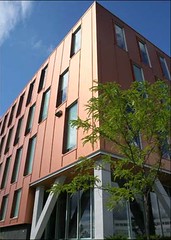 The one on building energy (GIBp2) has a lot of new language in this draft, but unless I'm mistaken the new language doesn't change the content; it is designed to make the standard more precise and relatable to external standards.
The one on building energy (GIBp2) has a lot of new language in this draft, but unless I'm mistaken the new language doesn't change the content; it is designed to make the standard more precise and relatable to external standards.
I'll confess to a bit of ambivalence over the one on certified green buildings, because in general I think LEED-ND should reward performance, not documentation. Given that we have performance prerequisites for energy and water efficiency, it seems a little incestuous to exclude an applicant unless s/he also participates in two LEED programs, and I have some concern that the extra trouble associated with that could scare off some potential participants.
The requirement was added partly as a result of a LEED-ND pilot project, a single building that qualified for certification despite doing nothing at all for green building. It seemed like forum-shopping, the developer simply choosing the LEED program that was easier for his situation. I don't have a huge problem with the prerequisite, but I think we could have ruled out single buildings altogether for "neighborhood" certification or simply relied on performance criteria (such as GIBp1, GIBp2, and GIBp3) to achieve an equally satisfactory result.
Special issues in the GIB credits: historic preservation
The credits for existing building reuse (GIBc5) and historic preservation (GIBc6) contain language providing that those credits may not be earned if the applicant demolishes an historic landmark or alters an historic landscape, except where authorized by the appropriate review board. This language should, in my opinion, be a prerequisite, not just part of a credit. There is no way that we should be honoring development as green if it is demolishing landmarks.
A prerequisite to that effect was proposed in the drafting process, but it failed for the reasons I cited in my blog a few months ago. 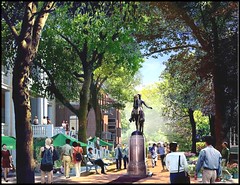 While there could, in fact, be instances of abuse where NIMBYs rush to landmark something of dubious cultural value specifically to block a smart development, I believe a prerequisite could have included language to minimize that risk, and I think we made a mistake by categorically rejecting a requirement on this issue.
While there could, in fact, be instances of abuse where NIMBYs rush to landmark something of dubious cultural value specifically to block a smart development, I believe a prerequisite could have included language to minimize that risk, and I think we made a mistake by categorically rejecting a requirement on this issue.
Beyond that issue, the historic preservation credit contains new language to clarify that preservation of historic landscapes will be credited, in addition to preservation of historic buildings. This is a good change worthy of support.
I also believe that these credits are worthy of more points than they are assigned. But the hysterical criticism we have received for not having more credit points is misplaced, in my opinion. The critics' point is that historic buildings are inherently more sustainable than new buildings, which I will grant is sometimes the case. But, when it is, a LEED-ND applicant will garner more points because of the project's superior performance achievement under the credits that measure performance. Historic buildings and neighborhoods are typically much better located than sprawl, for instance, and our system will reward that. Where they avoid site disturbance, save building energy, and so on, our system will reward those things, too. That is as it should be in an environmental rating program.
Special issues in the GIB credits: stormwater management
This credit (GIBc8) has been improved, in my opinion. As before, it sets up a tiered system of point earnings, giving increasing credit to developments that capture and manage rainfall in increasing increments. It is strictly performance-based, allowing flexibility for developers to achieve results however they wish.
Where it gets a little tricky is for highly urban projects, without much green space to work with and where stormwater management can be more expensive. 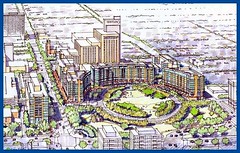 A significant part of the committee wanted to make sure that LEED-ND did not create a disincentive for urban infill and brownfield development. This issue is dealt with in the credit by awarding a bonus point for these kinds of projects, so long as they do enough to achieve two credit points under the credit's structure. This allows them to receive three or four points for the same amount of performance achievement that a greenfield development would receive only two or three points for.
A significant part of the committee wanted to make sure that LEED-ND did not create a disincentive for urban infill and brownfield development. This issue is dealt with in the credit by awarding a bonus point for these kinds of projects, so long as they do enough to achieve two credit points under the credit's structure. This allows them to receive three or four points for the same amount of performance achievement that a greenfield development would receive only two or three points for.
This mechanism is a little clumsy, and it can be argued that urban projects receive their points for being urban elsewhere in the system and do not need a bonus here. I'm a little ambivalent but tend to agree with that more than not. The good news for stormwater management, though, is that the value of the bonus was reduced from two points to one, and the base level of achievement required to qualify for the bonus was raised. It's probably a decent compromise.
The other GIB credits
For the most part, these have received only minor substantive changes from the earlier draft, although there is a good bit of new technical language to make the standards more precise. I will comment on just a few of them:
- GIBc1 - certified green buildings: I don't have any ambivalence at all about awarding credit points to developments that include certified green buildings (as opposed to a prerequisite requiring them). This credit is perfectly appropriate, even though it overlaps a little with some of the performance-based credits.
- GIBc2 - building energy efficiency: Like the energy efficiency prerequisite, this standard contains new technical language to make it more precise and relatable to external standards.
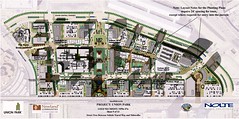 The thresholds for earning points have also changed somewhat, but it is beyond my expertise to evaluate the changes.
The thresholds for earning points have also changed somewhat, but it is beyond my expertise to evaluate the changes. - GIBc3 - building water efficiency: This is a new credit, awarding a point to developments whose buildings are 40 percent more water-efficient than baseline. (The prerequisite requires 20 percent improvement.) I believe it is appropriate.
- GIBc11 - on-site renewable energy: There is no real change to this one, but I do want to address some strong criticism we received in the previous round of comments for not awarding it more value in the system ("worthless" was the word used by one green blogger). My response is simple: First, I think we should be careful about allocating points to measures that are difficult for small infill projects to earn, and they generally have no ability to use some of the more common methods for on-site renewable generation. (We certainly should not require it, as the blogger asserted.) Second, and more important, the environment doesn't care how we save energy, whether it is by on-site renewables or through other efficiency measures. If the savings are real and can be measured, LEED-ND will reward the applicant in such credits as those for certified buildings (up to 5 points), building energy efficiency (up to 2 points), and infrastructure energy efficiency (1 point). We also award points for other energy-saving measures such as heat island reduction, solar orientation, district heating and cooling, reduced automobile dependence, and other transportation measures. If a developer takes advantage of all these opportunities for energy savings, s/he can earn as many as 30 points, by my quick estimate. That is far from "worthless."
- GIBc14 - wastewater management: The value of this one was reduced from three to two points to make room for the new building water efficiency credit. If points are reallocated, we should try to restore the lost point.
Random thoughts before concluding
Beyond the GIB category, LEED-ND makes an additional ten credit points available for innovation (up to five points for going above and beyond the system's specified standards, awarded somewhat but not entirely ad hoc), employing a LEED "accredited professional" on the project team (or smart growth/new urbanism equivalent), 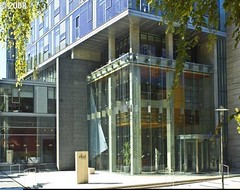 or complying with credits determined by regional chapters and organizations to be of special regional significance.
or complying with credits determined by regional chapters and organizations to be of special regional significance.
To be honest, I'm not entirely thrilled with these. I believe LEED-ND should award exactly the same amount of credit to two identical projects, regardless of whether one of them hired an accredited professional to help get there. This is basically just a marketing tool for the Green Building Council's accreditation program (which, if truly effective, should not need the boost here), but I understand that it is in the system to stay. I don't have a problem with the other two categories in principle, but I do think that including such "extra" points devalues the more specific credits and, in general, makes certification easier to earn unless the required number of points for certification is raised accordingly (which it hasn't been). USGBC believes strongly in these categories, though, and has no apparent intention of tinkering with the required number of points for certification.
Finally, I suspect that by now I have lost a good bit of my audience with all these technical minutiae. I wanted to do it, though, for that portion of the audience that is following LEED-ND. Next week we'll be back to the good stuff.